
Rome. Les Capitales De L'Europe. Promenades Pittoresques. Rome. Vue de Capitole.
Par M. Charles Malo.
Paris, Marcilly Fils Ainé, Rue S.-Jacques, No.21. Imprimerie de A. Firmin Didot, Rue Jacob, No.24. No.53 R. de la Paroisse, Boullenger, Md. Papetier a Versailles.[n.d. c.1829.]
Small 12mo, 146 x 95mm (5¾ x 3¾"), yellow board cover embossed and with title printed in black; pp. 36, with hand-coloured aquatint. Some foxing.
Charles Malo (1790-1871) produced a series of books on the capital cities of Europe, in French, and recorded details of daily life in the cities, historical information and architectural details of churches and significant public buildings. The frontispiece view is the top of Capitoline Hill, with the façade of the Palazzo Senatorio and the cordonata. Vicaire V: 481. Gumuchian: 3918 & 3919.
[Ref: 17541] £480.00
view all images for this item
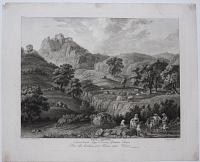
Rocca Giovine Généralement Supposée l'ancien Fanun Vacunae [...]
Peint à Gouache par J. Ph. Hackert 1780 Gravé à l'eau forte par B.A. Duncker et terminé par G. Eichler
Engraving, platemark: 380 x 470mm. (15 x 18¼"), with very large margins. Some creasing. Repaired tear in top margin.
View in the small rural village of Roccagiovine in the countryside outside Rome. It is now part of the Monti Lucretili natural park. One of a series of landscapes of the Roman countryside after gouaches by Philipp Hackert (1737 - 1807), painter and etcher. Born in Prenzlau north of Berlin, he came to Italy in 1768, settling in Rome where he joined a German group of artists also including Anton Raphael Mengs and the art historian Johann Joachim Winckelmann. In 1786 he settled in Naples as court painter to Ferdinand IV. Provenance: Torridon House Lovelace/King Family.
[Ref: 39574] £260.00
(£312.00 incl.VAT)
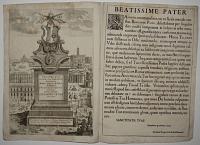
Prospectus Locorum Urbis Romæ Insicñ. Inventore Matthæo Gregorio de Rubeis Romano. Delineati et aere incisi a Livino Cruyl Gandavensi. Liber Primus. Alexandro VII P M Dicatus.
Romæ Typis Joannis Baptistæ de Rubeis Mediolanensis in foro Agonali Anno D. 1666, cum Privilegio Summi Pont.
Engraved titlepage, 385 x 260 (15¼ x 10¼"), with letterpress dedication, large margins. Two pinholes in image, tear in margin, staining at top.
A decorative titlepage to Matteo Gregorio de Rossi's 'Prospectus locorum urbis Romae Insignium', with a central plynth containing the title, with some of the important buildings of Rome, including St Peter's Basilica, the Capidoglio and the Pantheon, arrayed behind. The 'Prospectus' contained this title and ten plates drawn and engraved by Lievin Cruyl (1634-90+), a Flemish priest, draughtsman and etcher from Ghent who was active in Rome from 1664 until c.1670. He is credited helping develop the style of 'veduta' topography, pre-dating Piranesi by nearly a century. The focus of the 'Prospectus' was the building campaign of Pope Alexander VII (to whom the work is dedicated); apparently Cruyl drew buildings that were not yet finished from architects plans. Matteo Gregorio de Rossi (1638-1702) was the son and successor of the publisher Giovanni Battista de Rossi.
[Ref: 48182] £490.00
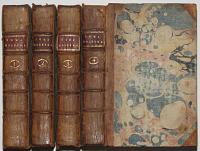
Accurata, e succinta descrizione topografica e istorica di Roma Moderna Opera Postuma dell'Abate Ridolfino Venuti Cortonese...
In Roma MDCCLXVIII. Presso Carlo Barbiellini.
4 vols, 8vo, half calf with marbled boards; pp. xii +1300 (inc. half-title and four titles), 54 folding engraved plates. Spines distressed, tear in vol. 1 x6, otherwise fine. Ownership inscription 'W. Rooker Rome 1778' on half-title.
A study of the buildings of Rome, written by abbot Ridolfino Venuti (1705-63), with several etched plates by Giovanni Battista Piranesi.
[Ref: 35768] £2,500.00
view all images for this item
![[Domus Aurea, Rome]](img-thumbnail/jpegs/33418.jpg)
[Domus Aurea, Rome] Domus aurea Neronis, aus welchem Herzlichen gebäü
J.B. F. v. E. delineavit
Cum Pri: Sac Caes: Majest: [Leipzig, 1725]
Engraving with very large margins, platemark 300 x 430mm (11¾ x 17"). Text in French and German; foxing to margins only. Crease.
The Domus Aurea, a large villa built by Nero after the fire in AD 64 destroyed residences on the slope of the Palatine Hill. Beneath the text are the famous verses written on the city walls or spread verbally, reported by Suetonius and Martial. Plate from Austrian architect Johann Bernard Fischer von Erlach's 'Entwurf einer historischen Architektur' ('Outline of Historical Architecture', first published 1721) , the first comparative architecture of all periods and nations. When Fischer designed Vienna's Imperial Stables, they were explicitly based upon Nero's villa. For Vienna's Imperial Stables, see ref.33399
[Ref: 33418] £350.00
![Li Moccoletti [in pencil].](img-thumbnail/jpegs/21084.jpg)
Li Moccoletti [in pencil].
[n.d., c.1830.]
Aquatint with fine hand colour, heightened with gum arabic. 205 x 285mm, 8¼ x 11¼". Margins creased.
'Li Moccolati' (i.e. stumps of candles), in which everyone tried to put out overyone else's candles, marked the end of the Roman carnival and the beginning of Lent. It was held in la Corso and the surrounding streets.
[Ref: 21084] £220.00
(£264.00 incl.VAT)
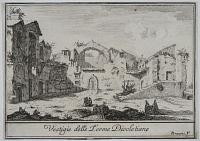
Vestigie delle Terme Diocletiane.
Piranesi F.
[n.d. c.1745.]
Etching. 131 x 185mm (5¼ x 11¼"). Trimmed.
The Baths of Diocletian were the largest and most sumptuous of imperial and ancient Rome.
[Ref: 20390] £160.00
(£192.00 incl.VAT)
![[Veduta degl'avanzi della Curia Ostilia sul Monte Celio.]](img-thumbnail/jpegs/17100.jpg)
[Veduta degl'avanzi della Curia Ostilia sul Monte Celio.]
Rossini fece Roma 1817.
Etching, proof before letters. 205 x 300mm (8 x 11¾"), with very large margins. Some rubbing.
According to Rossini these are the remains of the Curia Hostilia, an early Senate House built by Tullius Hostilius, the third king of Rome, on Monte Caelio. However it is more likely to be a substructure of the Temple of Claudius. Published as the frontispiece to Luigi Rossini's 'Antichita di Roma divise in 40 vedute'. See BM: 1935,0520.68 [lettered].
[Ref: 17100] £160.00
(£192.00 incl.VAT)
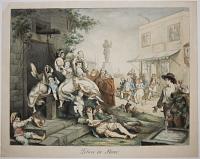
Leben in Rom.
Hein.ch inv.t: del.t et inct. Hannover 1797.
Etching with hand colour, fine & rare. 435 x 535mm (17 x 21"). Trimmed within the plate at the bottom.
'Life in Rome', satirising the attractions of the city to Grand Tourists. Four girls with open bodices sit on a swing suspended in a doorway, playing tamborines, with a group of monks and a man playing the lute lying beneath all enjoying the view. Across the road tourists sit outside a coffee shop and a man sells wine from barrels on his donkey.
[Ref: 48521] £750.00

Veduta del Condotto dell'Acqua Vergine situato alla Chiavica del Bufalo.
Rossini dis. e inc.
Roma 1822.
Etching. 370 x 455mm (14½ x 18"), with large margins, uncut.
The Acqua Vergine aquaduct was built by Marcus Agrippa in 19 BC, primarily to supply Agrippa's Baths. Said to have the purest water in Rome, it supplies the Trevi Fountain, fountains in Piazza Navona and di Spagna. The first state, before the plate number, issued unbound. From an early 19th century folder titled 'Roman Engravings. The Property of Major E.G.G. Rugdon[?]'.
[Ref: 51544] £400.00
![[Aqua Julia] Veduta del Castello dell' Acqua Giulia. secondi lo scavo fatto in quest'anno 1822 nella Via Tiburtina.](img-thumbnail/jpegs/51560.jpg)
[Aqua Julia] Veduta del Castello dell' Acqua Giulia. secondi lo scavo fatto in quest'anno 1822 nella Via Tiburtina.
Rossini dis. e inc.
Roma 1822.
Etching. 350 x 450mm (13¾ x 17¾"), with large margins, uncut.
The ruins of a castle, probably built to protect the Aqua Julia, Rome's water supply. According to the title the building was being excavated at the time of the view. The first state, before the plate number, issued unbound. From an early 19th century folder titled 'Roman Engravings. The Property of Major E.G.G. Rugdon[?]'.
[Ref: 51560] £400.00
![[Arch of Dolabella] Veduta della Fornice de Consoli Dolabella, e Silano, investila dagli Archi Neroniani provenienti dal Condotto dell'Aqua Claudia.~](img-thumbnail/jpegs/51551.jpg)
[Arch of Dolabella] Veduta della Fornice de Consoli Dolabella, e Silano, investila dagli Archi Neroniani provenienti dal Condotto dell'Aqua Claudia.~
Rossini dis. e inc.
Roma 1821.
Etching. 460 x 390mm (18 x 15½"), with large margins, uncut. Crease at the top.
The Arch of Dolabella and Silanus, a rebuilding of one of the gates of the Servian Walls in 10 AD by the consuls P. Cornelius Dolabella and C. Junius Silanus. Nero's extension of the Acqua Claudia was built over the top of the arch. The first state, before the plate number, issued unbound. From an early 19th century folder titled 'Roman Engravings. The Property of Major E.G.G. Rugdon[?]'.
[Ref: 51551] £400.00
![[Arch of Drusus] Arco di Druso, e Porta Capena.](img-thumbnail/jpegs/51566.jpg)
[Arch of Drusus] Arco di Druso, e Porta Capena.
Rossini dis. e inc.
Roma 1820.
Etching. 390 x 460mm (15¼ x 18"), with large margins, uncut. Printer's creases just entering image.
A view of an arch at the beginning of the Appian Way known as the Arch of Drusus (for Nero Claudius Drusus, the conqueror of the Germans) but probably built later. Some years after construction the arch was utilised by the builders of the Aqua Antoniniana, a branch of the Aqua Marcia. Through the arch is the Porta Capena, a gate in the Servian wall. The first state, before the plate number, issued unbound. From an early 19th century folder titled 'Roman Engravings. The Property of Major E.G.G. Rugdon[?]'.
[Ref: 51566] £300.00
![[Arch of Drusus] Arco di Druso su del quale passava il Condotto Antoniano.](img-thumbnail/jpegs/51529.jpg)
[Arch of Drusus] Arco di Druso su del quale passava il Condotto Antoniano.
Rossini dis. e inc.
Roma 1819.
Etching. 455 x 355mm (18 x 14"), with large margins, uncut.
A view of an arch at the beginning of the Appian Way known as the Arch of Drusus (for Nero Claudius Drusus, the conqueror of the Germans) but probably built later. Some years after construction the arch was utilised by the builders of the Aqua Antoniniana, a branch of the Aqua Marcia. The first state, before the plate number, issued unbound. From an early 19th century folder titled 'Roman Engravings. The Property of Major E.G.G. Rugdon[?]'.
[Ref: 51529] £400.00
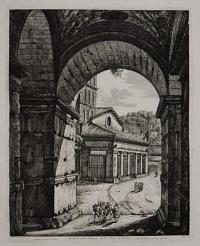
Veduta dell' Interno dell'Araco du Giano.
Rossini dis. e inc.
Roma 1820.
Etching. 475 x 375mm (18¾ x 14¾"), with large margins, uncut.
A view from under the so-called Arch of Janus, the only quadrifrons triumphal arch remaining in Rome, at the edge of the Forum Boarium (cattle market). The church is the seventh century San Giorgio in Velabro, founded on the spot that Romulus and Remus were found by the she-wolf. The first state, before the plate number, issued unbound. From an early 19th century folder titled 'Roman Engravings. The Property of Major E.G.G. Rugdon[?]'.
[Ref: 51531] £400.00
![[Arch of Janus] Veduta di Fianco dell'Arco di Giano.](img-thumbnail/jpegs/51533.jpg)
[Arch of Janus] Veduta di Fianco dell'Arco di Giano.
Rossini dis. e inc.
Roma 1820.
Etching. 455 x 365mm (18 x 14½"), with large margins, uncut.
The so-called Arch of Janus, the only quadrifrons triumphal arch remaining in Rome, at the edge of the Forum Boarium (cattle market). During the Middle Ages the Frangipane family transformed the building into a fortress, ensuing the building remained intact. However in 1830 the attic and top (as shown here) were torn down in the mistaken belief they were later additions. To the left are the Arcus Argentariorum (Arch of the Moneychangers), and the seventh century church of San Giorgio al Velabro. The first state, before the plate number, issued unbound. From an early 19th century folder titled 'Roman Engravings. The Property of Major E.G.G. Rugdon[?]'.
[Ref: 51533] £600.00
![[Arch of Septimius Severus] Veduta dell' Arco di Settimio.](img-thumbnail/jpegs/51485.jpg)
[Arch of Septimius Severus] Veduta dell' Arco di Settimio.
Rossini dis. e inc.
Roma 1820.
Etching. 370 x 570mm (14½ x 22½"), with very large, uncut margins.
A view of the Arch of Septimius Severus from the Forum, with the steps of the Capitoline Hill in the background. It is shown before the original street level was excavated by Carlo Fea in 1803, removing sediement washed into the Forum by floodwater. The first state, before the plate number, issued unbound. From an early 19th century folder titled 'Roman Engravings. The Property of Major E.G.G. Rugdon[?]'.
[Ref: 51485] £750.00
![[Arcus Argentariorum] Veduta dell'Arco di Settimio Severo nel Foro Boario.](img-thumbnail/jpegs/51564.jpg)
[Arcus Argentariorum] Veduta dell'Arco di Settimio Severo nel Foro Boario.
Rossini dis. e inc.
Roma 1821.
Etching. 405 x 485mm (15¾ x 19"), with large margins, uncut.
A view of the Arcus Argentariorum (Arch of the Moneychangers), a small arch in the Forum Boarium (the cattle Market). According to the inscription it was commissioned by the local money-changers and merchants in honour of emperor Septimus Severus and his family. It is now joined to the western wall of the seventh century church of San Giorgio al Velabro. This plate has one of the more dramatic scenes drawn by Bartolomeo Pinelli to add life to Rossini's architecture, a knife-fight. The first state, before the plate number, issued unbound. From an early 19th century folder titled 'Roman Engravings. The Property of Major E.G.G. Rugdon[?]'.
[Ref: 51564] £600.00
![[Arcus Neroniani.] Veduta dei Grandi Avanzi degli Aquedotti di Nerone _ vicino a Porte S. Giovanni.](img-thumbnail/jpegs/51545.jpg)
[Arcus Neroniani.] Veduta dei Grandi Avanzi degli Aquedotti di Nerone _ vicino a Porte S. Giovanni.
Rossini dis. e inc.
Roma 1823.
Etching. 435 x 540mm (17 x 21¼"), with large margins, uncut.
The Arcus Neroniani, an extension of the Acqua Claudia built by Nero to supply water to the Caelian Hill. The first state, before the plate number, issued unbound. From an early 19th century folder titled 'Roman Engravings. The Property of Major E.G.G. Rugdon[?]'.
[Ref: 51545] £400.00
![[The Aurelian Walls] Veduta della Mura di Roma, dalla parte interna della Città, vicino alla Porta Celimontana.](img-thumbnail/jpegs/51496.jpg)
[The Aurelian Walls] Veduta della Mura di Roma, dalla parte interna della Città, vicino alla Porta Celimontana.
Rossini dis. e inc.
Roma 1823.
Etching. 425 x 660mm (16¾ x 26"), with large, uncut margins.
A view of part of the Aurelian walls, which made use of the existing Aqua Claudia. This section is now in the Giardini di via Carlo Felice. The walls point towards the minor basilica Santa Croce in Gerusalemme. The first state, before the plate number, issued unbound. From an early 19th century folder titled 'Roman Engravings. The Property of Major E.G.G. Rugdon[?]'.
[Ref: 51496] £600.00
![[Basilica of Maxentius] Veduta D'una delle navate minori, della Tempio Pace.](img-thumbnail/jpegs/51555.jpg)
[Basilica of Maxentius] Veduta D'una delle navate minori, della Tempio Pace.
Rossini dis. e inc.
Roma 1819.
Etching. 560 x 455mm (22 x 18"), with large margins, uncut.
The interior of the Basilica of Maxentius and Constantine, showing the remaining north aisle with its brick walls and arches supporting the concrete vaults, with the octagonal ceiling coffers. Begun by Maxentius in 308 AD, the building was completed in 312 by Constantine after he defeated Maxentius at Milvian Bridge. It was the largest building in the Forum Romanum. The first state, before the plate number, issued unbound. From an early 19th century folder titled 'Roman Engravings. The Property of Major E.G.G. Rugdon[?]'.
[Ref: 51555] £600.00
![[Basilica of Maxentius] Veduta Generale del gran Tempio della Pace.](img-thumbnail/jpegs/51520.jpg)
[Basilica of Maxentius] Veduta Generale del gran Tempio della Pace.
Rossini dis. e inc.
Roma 1822.
Etching. 440 x 660mm (17¼ x 26"), with large margins, uncut.
A view showing the octagonal ceiling coffers of the concrete barrel vaults of the Basilica of Maxentius and Constantine, the largest building in the Forum of Rome. Begun by Maxentius in 308 AD the building was completed in 312 by Constantine after he defeated Maxentius at Milvian Bridge. The first state, before the plate number, issued unbound. From an early 19th century folder titled 'Roman Engravings. The Property of Major E.G.G. Rugdon[?]'.
[Ref: 51520] £400.00
![[Baths of Diocletian] Veduta degl' Avanzi del secondo piano delle Terme Diocleziane.](img-thumbnail/jpegs/5181.jpg)
[Baths of Diocletian] Veduta degl' Avanzi del secondo piano delle Terme Diocleziane.
Rossini dis. e inc.
Roma 1823.
Etching. 540 x 390mm (23¾ x 15¼"), trimmed to the image.
The Baths of Diocletian were the largest of the public baths and were capable of accommodating 3,000 bathers at the same time. The tepidarium and the central hall are now the church of S. Maria degli Angeli, a side hall is the church of S. Bernardo.
[Ref: 5181] £240.00
(£288.00 incl.VAT)
![[Baths of Diocletian] Veduta degl' Avanzi del secondo piano delle Terme Diocleziane.](img-thumbnail/jpegs/51567.jpg)
[Baths of Diocletian] Veduta degl' Avanzi del secondo piano delle Terme Diocleziane.
Rossini dis. e inc.
Roma 1823.
Etching. 540 x 390mm (23¾ x 15¼"), with large margins, uncut. Crease.
The Baths of Diocletian were the largest of the public baths and were capable of accommodating 3,000 bathers at the same time. The tepidarium and the central hall are now the church of S. Maria degli Angeli; a side hall is the church of S. Bernardo. The first state, before the plate number, issued unbound. From an early 19th century folder titled 'Roman Engravings. The Property of Major E.G.G. Rugdon[?]'.
[Ref: 51567] £300.00
![[Capitoline Hill] Veduta di Fianco del Campidoglio di Roma.](img-thumbnail/jpegs/51484.jpg)
[Capitoline Hill] Veduta di Fianco del Campidoglio di Roma.
Rossini dis & inc.
Roma 1819.
Etching. 440 x 550mm (17¼ x 21¾"), with very large, uncut margins.
A side view of the Piazza del Campidoglio, designed by Michaelangelo in the 16th century, with one of the Dioscuri (Castor & Pollux), the two stone horsemen guarding the cordonata. The first state, before the plate number, issued unbound. From an early 19th century folder titled 'Roman Engravings. The Property of Major E.G.G. Rugdon[?]'.
[Ref: 51484] £900.00
![[Capitoline Hill] Veduta del Campidoglio Romano.](img-thumbnail/jpegs/51491.jpg)
[Capitoline Hill] Veduta del Campidoglio Romano.
Rossini dis. e inc.
Roma 1823.
Etching. 365 x 450mm (14½ x 17¾"), with very large uncut margins.
A view of the Capitoline Hill leading from Via del Teatro di Marcello to Piazza del Campidoglio, as designed by Michelangelo Buonarroti in 1536-46. At the top of the cordonata are the statues of the Dioscuri (Castor & Pollux, the Horse Tamers), with the façade of Palazzo Senatorio behind. The first state, before the plate number, issued unbound. From an early 19th century folder titled 'Roman Engravings. The Property of Major E.G.G. Rugdon[?]'.
[Ref: 51491] £900.00

Avanzo della Casa di Cola di Rienzo.
Rossini dis. e inc.
Roma 1820.
Etching. 370 x 465mm (17½ x 18¼"), with large margins, uncut. Some loss of margin top right.
The so-called 'Casa di Cola di Rienzo', a tower in the Piazza Trilussa erected between 1040-65 by a powerful Crescenzi family in the 10th century to control the wharves of Rome, built using material scavenged from classical ruins. There is no direct connection with Cola di Rienzi, a populist politician (1313-54) eventually murdered by a mob, merely that he was born in the area. The first state, before the plate number, issued unbound. From an early 19th century folder titled 'Roman Engravings. The Property of Major E.G.G. Rugdon[?]'.
[Ref: 51553] £600.00
![[Castel Sant'Angelo] Veduta Generale della gran Mole Adriana, e Ponte Elio _ in oggi Ponte e Castel S.Angelo.](img-thumbnail/jpegs/51490.jpg)
[Castel Sant'Angelo] Veduta Generale della gran Mole Adriana, e Ponte Elio _ in oggi Ponte e Castel S.Angelo.
Rossini dis. e inc.
Roma 1823.
Etching. 355 x 535mm (14 x 21"), with very large, uncut margins.
A general view looking along the Tiber to the Aelian Bridge and the Mausoleum of Hadrian, both built by the emperor Hadrian between 134 - 139, and now known as the Ponte Sant'Angelo and Castel Sant'Angelo. Behind the bridge is the dome of St Peter's Basilica in the Vatican. The first state, before the plate number, issued unbound. From an early 19th century folder titled 'Roman Engravings. The Property of Major E.G.G. Rugdon[?]'.
[Ref: 51490] £900.00
![[Castel Sant'Angelo] Veduta della Gran Mole Adriana, e Ponte Elio, in oggi Ponte, e Castel S.t Angelo.](img-thumbnail/jpegs/51499.jpg)
[Castel Sant'Angelo] Veduta della Gran Mole Adriana, e Ponte Elio, in oggi Ponte, e Castel S.t Angelo.
Rossini dis. e inc.
Roma 1821.
Etching. 445 x 555mm (17¾ x 21¾"), with very large, uncut margins. Wear to edge of left margin.
A view from the banks of the Tiber looking up at the Aelian Bridge and the Mausoleum of Hadrian, both built by the emperor Hadrian between 134 - 139, and now known as the Ponte Sant'Angelo and Castel Sant'Angelo. The first state, before the plate number, issued unbound. From an early 19th century folder titled 'Roman Engravings. The Property of Major E.G.G. Rugdon[?]'.
[Ref: 51499] £900.00
![[Colosseum] Veduta di porzione degli avanzi dell'Ambularco del piano terra nel Colosseo.](img-thumbnail/jpegs/51511.jpg)
[Colosseum] Veduta di porzione degli avanzi dell'Ambularco del piano terra nel Colosseo.
Rossini dis. e inc.
Roma 1821.
Etching. 465 x 395mm (18¼ x 15½"), with large margins, uncut.
A view of the interior spectator passageway with the vomitoria, the doors into the seating areas and out of the building. The first state, before the plate number, issued unbound. From an early 19th century folder titled 'Roman Engravings. The Property of Major E.G.G. Rugdon[?]'.
[Ref: 51511] £600.00
![[Colosseum] Veduta del grande' interno dell'Anfiteatro Flavio, detto il Colosseo.](img-thumbnail/jpegs/51495.jpg)
[Colosseum] Veduta del grande' interno dell'Anfiteatro Flavio, detto il Colosseo.
Rossini dis. e inc.
Roma 1823.
Etching. 460 x 665mm (18 x 26¼"), with very large, uncut margins. Some wear to the top margin.
A general view of the vast interior of the Colosseum. Among the figures, drawn by Bartolomeo Pinelli to add life to Rossini's architecture, is a procession of monks. The first state, before the plate number, issued unbound. From an early 19th century folder titled 'Roman Engravings. The Property of Major E.G.G. Rugdon[?]'.
[Ref: 51495] £700.00
![[Colosseum] Veduta dell'altro principale Ingresso, del Colosseo.](img-thumbnail/jpegs/51512.jpg)
[Colosseum] Veduta dell'altro principale Ingresso, del Colosseo.
Rossini dis. e inc.
Roma 1821.
Etching. 540 x 385mm (21¼") x 15¼"), with large margins, uncut. Repaired tear in image.
One of the principal vomitoria of the Colosseum, looking out towards Temple of Venus and Roma, the largest temple in Rome, designed by Hadrian. The first state, before the plate number, issued unbound. From an early 19th century folder titled 'Roman Engravings. The Property of Major E.G.G. Rugdon[?]'.
[Ref: 51512] £600.00
![[Colosseum] Veduta degl'avanzi d'uno de principali ingressi del Colosseo.](img-thumbnail/jpegs/51510.jpg)
[Colosseum] Veduta degl'avanzi d'uno de principali ingressi del Colosseo.
Rossini dis. e inc.
Roma 1819.
Etching. 455 x 360mm (18 x 14¼"), with large margins, uncut.
An archway looking into the arena of the Colosseum. The first state, before the plate number, issued unbound. From an early 19th century folder titled 'Roman Engravings. The Property of Major E.G.G. Rugdon[?]'.
[Ref: 51510] £600.00
![[Column of Marcus Aurelius] Veduta della Colonna Antonina, o sia Piazza Colonna.](img-thumbnail/jpegs/51481.jpg)
[Column of Marcus Aurelius] Veduta della Colonna Antonina, o sia Piazza Colonna.
Rossini dis. e inc.
Roma 1823.
Etching. 565 x 455mm (22¼ x 18"), with very large, uncut margins.
The Column of Marcus Aurelius Antoninus (emperor from 161 to 180) in Piazza Colonna, which has a spiral frieze depicting the emperor's wars on the Danube. In 1589 pope Sixtus V placed a bronze statue of the apostle St. Paul on top. The first state, before the plate number, issued unbound. From an early 19th century folder titled 'Roman Engravings. The Property of Major E.G.G. Rugdon[?]'.
[Ref: 51481] £750.00
![['Curia Hostilia'] Avanzi della Curia Ostilius sul Monte Celio.](img-thumbnail/jpegs/51521.jpg)
['Curia Hostilia'] Avanzi della Curia Ostilius sul Monte Celio.
Rossini dis. e inc.
Roma 1823.
Etching. 390 x 540mm (15½ x 21¼"), with large margins, uncut.
According to Rossini's title (one of the few in the image rather than underneath), these are the remains of the Curia Hostilia, an early Senate House built by Tullius Hostilius, the third king of Rome, on Monte Caelio. However it is more likely to be a substructure of the Temple of Claudius on the Caelian Hill. Through the gateway to the left is the Arch of Constantine. The first state, before the plate number, issued unbound. From an early 19th century folder titled 'Roman Engravings. The Property of Major E.G.G. Rugdon[?]'.
[Ref: 51521] £600.00
![[Domus Severiana] Veduta degli Avanzi della Casa Aurea di Nerone, sul Monte Palatino, Della porte riguardante il Circo Massimo.](img-thumbnail/jpegs/51557.jpg)
[Domus Severiana] Veduta degli Avanzi della Casa Aurea di Nerone, sul Monte Palatino, Della porte riguardante il Circo Massimo.
Rossini dis. e inc.
Roma 1823.
Etching. 390 x 540mm (15¼ x 21¼"), with large margins, uncut. Crease lower right.
The arches built to extend the Palatine Hill out for the construction of the Domus Severiana by Septimus Severus, which included a palace and baths. Rossini equates the building to the Domus Aurea ('Golden House'), the palace of entertainment built by Nero in AD 64 after the famous fire that destroyed much of Rome (when he 'fiddled'). The first state, before the plate number, issued unbound. From an early 19th century folder titled 'Roman Engravings. The Property of Major E.G.G. Rugdon[?]'.
[Ref: 51557] £400.00
![[Forum] Veduta dello Scavo della Colonna di Foca.](img-thumbnail/jpegs/51489.jpg)
[Forum] Veduta dello Scavo della Colonna di Foca.
Rossini dis. e inc.
Roma 1822.
Etching. 375 x 575mm (14¾ x 22½"), with very large, uncut margins. Old repaired tear in the bottom margin.
A view of the north-west end of the Roman Forum, centred on the Arch of Septimus Severus, with the Church of Santi Luca e Martina behind. On the left are the three columns of the pronaos of the Temple of Vespasian and Titus; on the right is the column of Phocas, the last monument erected in the Forum, dedicated to the Eastern Roman Emperor Phocas (ruled 602 - 610). The first state, before the plate number, issued unbound. From an early 19th century folder titled 'Roman Engravings. The Property of Major E.G.G. Rugdon[?]'.
[Ref: 51489] £900.00
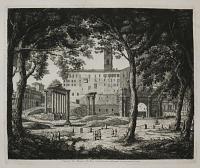
Parte del Foro Romano, e del Monte Capitolino preso dalla parte ov'erano situati li rostri.
Rossini dis. e inc.
Roma 1827.
Etching. 370 x 450mm (14½ x 17¾"), with large margins, uncut.
A view of the north west end of the Roman Forum, with the Palazzo Senatorio on Monte Capitolino. The first state, before the plate number, issued unbound. From an early 19th century folder titled 'Roman Engravings. The Property of Major E.G.G. Rugdon[?]'.
[Ref: 51532] £600.00
![[Le Colonnacce] Avanzi del Foro di Nerva dal volgo le Colonnacce.](img-thumbnail/jpegs/51563.jpg)
[Le Colonnacce] Avanzi del Foro di Nerva dal volgo le Colonnacce.
Rossini dis. e inc.
Roma 1820.
Etching. 460 x 370mm (18¼ x 14½"), with large margins, uncut.
The only surviving portion of the columns that projected from the walls of the Forum of Nerva, with a figure of Minerva on the attic. The first state, before the plate number, issued unbound. From an early 19th century folder titled 'Roman Engravings. The Property of Major E.G.G. Rugdon[?]'.
[Ref: 51563] £600.00
![[Forum of Nerva] Veduta della parte postieriore degl'avanzi del Foro di Nerva da altri Erario publico](img-thumbnail/jpegs/51522.jpg)
[Forum of Nerva] Veduta della parte postieriore degl'avanzi del Foro di Nerva da altri Erario publico _ in oggi Arco de' Pantani.
Rossini dis. e inc.
Roma 1823.
Etching. 470 x 650mm (18½ x 25½"), with large margins, uncut.
The back outer wall of the Forum of Nerva, from what is now the Via Tor de' Conti, showing the Arco de' Pantani and three Corinthian columns of the Temple of Mars Ultor and the tower of the Basilian basilica. The first state, before the plate number, issued unbound. From an early 19th century folder titled 'Roman Engravings. The Property of Major E.G.G. Rugdon[?]'.
[Ref: 51522] £600.00
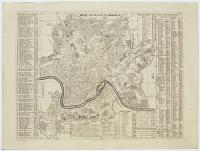
Rome Ancienne et Modern.
[Amsterdam, Henri Abraham Chatelain, c.1720.]
Engraved map. 340 x 450mm (13½ x 17½"). There is an 18th century watermark. Tear in margin which are very large.
Plan of Rome with extensive keys of ancient and modern buildings and monuments.
[Ref: 23605] £260.00

A View of Marcellus's Theatre at Rome.
Piranesi delin. T. Bowles sculp.
Published 12th May 1794 by Laurie & Whittle, 53 Fleet Street, London. Publish'd according to act of Parliament.
Engraving with hand-colouring. 280 x 430mm (11 x 17"), with wide margins. Tear extending into image on left. Slight foxing.
The ancient theatre of Marcellusin Rome. Named after Marcus Marcellus, Augustus' nephew, who died five years before the theatre was completed, it was formally inaugurated in 12BC by Augustus. Engraving purporting to be after G.B. Piranesi, although differing in many ways from Piranesi's print of the building. Piranesi's name may have been used to give the impression of greater authenticity. One of a series of views re-published by Laurie & Whittle in the 1790s.
[Ref: 23149] £260.00
(£312.00 incl.VAT)
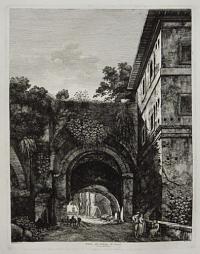
Avanzi del Palazzo de Cesari sul Monte Palatino.
Rossini dis. e inc.
Roma 1820.
Etching. 460 x 360mm (18 x 14¼"), with large margins, uncut.
A view of one of the ruins on the Palatine Hill, the preferred location of later imperial palaces. The first state, before the plate number, issued unbound. From an early 19th century folder titled 'Roman Engravings. The Property of Major E.G.G. Rugdon[?]'.
[Ref: 51547] £400.00
![[Ninfeo d'Egeria] Veduta della Fonte, e delle Spelonche d'Egeria _ fuori di Porta Capena.](img-thumbnail/jpegs/51543.jpg)
[Ninfeo d'Egeria] Veduta della Fonte, e delle Spelonche d'Egeria _ fuori di Porta Capena.
Rossini dis. e inc.
Roma 1823.
Etching. 400 x 610mm (21 x 24"), with large margins, uncut.
The Ninfeo d'Egeria (a nymphaeum dedicated to Egeria), a natural grotto fed by a spring, formalised by Herodes Atticus (101-177), with a statue of the nymph in the apse at the back. His estate is now the Caffarella Park. The first state, before the plate number, issued unbound. From an early 19th century folder titled 'Roman Engravings. The Property of Major E.G.G. Rugdon[?]'.
[Ref: 51543] £400.00
![[Pantheon] Veduta del Interno del Pronao del Pantheon.](img-thumbnail/jpegs/51514.jpg)
[Pantheon] Veduta del Interno del Pronao del Pantheon.
Rossini dis. e inc.
Roma 1820.
Etching. 440 x 550mm (17¼ x 21¾"), with large margins, uncut.
A view of the columns in the portico of the Pantheon, made from grey granite quarried in Egypt. Each column, weighing 60 tons, had to be dragged 62 miles from the quarry to the Nile, loaded into a barge, transferred to a galley to cross the Mediterranean to Ostia and back onto a barge to be taken up the Tiber, then moved the 700 metres to the building site. The first state, before the plate number, issued unbound. From an early 19th century folder titled 'Roman Engravings. The Property of Major E.G.G. Rugdon[?]'.
[Ref: 51514] £750.00
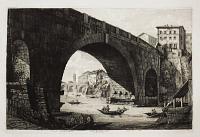
Veduta di Ponte Cestio dal Volgo Ponte ferrato.
Rossini dis. e inc.
Roma 1822.
Etching. 360 x 545mm (14¼ x 21½"), with very large, uncut margins. Slight soiling to edges.
The Ponte Cestio spans the Tiber from Tiber Island to the right bank and was originally built in the 1st century BC, although the bridge shown here is as rebuilt in the fourth century AD, using material from the demolished porticus of the Theatre of Marcellus. When the walls of the Tiber embankment were reconstructed 1888-92, the bridge had to be demolished and rebuilt, with the side arches widened. The first state, before the plate number, issued unbound. From an early 19th century folder titled 'Roman Engravings. The Property of Major E.G.G. Rugdon[?]'.
[Ref: 51479] £650.00

Veduta del Ponte di Nona fuori di Porta Maggiore, 9 miglia da Roma _ Questo Ponte è stato costruito su di una Valk per porre in piano la Via che portava all Città dei Gabbi, e lungo pa, 464. lar. 41.
Rossini dis. e inc.
Roma 1823.
Etching. 385 x 570mm (15¼ x 22½"), with large margins, uncut.
The Ponte di Nona, a viaduct of seven arches spanning 236 feet, was built in the 1st century BC nine miles up the Via Praenestina and is still in use. The first state, before the plate number, issued unbound. From an early 19th century folder titled 'Roman Engravings. The Property of Major E.G.G. Rugdon[?]'.
[Ref: 51523] £900.00

Veduta di Ponte Fabrizio dal volgo, detto quattro Capi.
Rossini dis. e inc.
Roma 1822.
Etching. 365 x 550mm (14¼ x 21¾"), with very large, uncut margins. Small scrape in the image.
The Ponte Fabricio, the oldest surviving bridge in Rome, having been built by Lucius Fabricius in 62 BC, joining Tiber island to the Campus Martius (the Fields of Mars). The first state, before the plate number, issued unbound. From an early 19th century folder titled 'Roman Engravings. The Property of Major E.G.G. Rugdon[?]'.
[Ref: 51482] £750.00
![[Ponte Milvio] Veduta Del Ponte Molle sul tevere. Due miglia lontano da Roma](img-thumbnail/jpegs/51502.jpg)
[Ponte Milvio] Veduta Del Ponte Molle sul tevere. Due miglia lontano da Roma _ Questo Ponte e Stato ristaurato, e costruito l'Arco Trianfale A. Dal Somma Pontefice Pio VIII Regnante.
Rossini dis. e inc.
Roma 1822.
Etching. 460 x 630mm (18 x 24¾"), with large, uncut margins.
The Ponte Milivio (or Milvian Bridge), a footbridge over the Tiber in the north of Rome, built by the Censor Aemilius Scaurus in 109BC, rebuilt and remodelled many times. Garibaldi's troops severely damaged it in an attempt to block a French invasion in 1849, after which it was repaired by Pope Pius IX. The modern trend of 'love padlocks' on bridges originated here. The first state, before the plate number, issued unbound. From an early 19th century folder titled 'Roman Engravings. The Property of Major E.G.G. Rugdon[?]'.
[Ref: 51502] £750.00

Veduta del Ponte Nomentoano. Sulla Via Nomentano.
Rossini dis. e inc.
Roma 1822.
Etching. 445 x 560mm (17½ x 22"), with large margins, uncut.
A view of Ponte Nomentano, a bridge over the Aniene, a tributary of the Tiber, north of Rome. Although the central arch is from the late-Republican period, the bridge was rebuilt by the Byzantine general Narses (a collegue of Belisarius) in 552. In 1849 French troops broke the arch to stop Garibaldi's advance, but it was repaired soon after. The bridge is now open to pedestrians in parkland. The first state, before the plate number, issued unbound. From an early 19th century folder titled 'Roman Engravings. The Property of Major E.G.G. Rugdon[?]'.
[Ref: 51519] £600.00




![[Domus Aurea, Rome]](img-thumbnail/jpegs/33418.jpg)
![Li Moccoletti [in pencil].](img-thumbnail/jpegs/21084.jpg)

![[Veduta degl'avanzi della Curia Ostilia sul Monte Celio.]](img-thumbnail/jpegs/17100.jpg)


![[Aqua Julia] Veduta del Castello dell' Acqua Giulia. secondi lo scavo fatto in quest'anno 1822 nella Via Tiburtina.](img-thumbnail/jpegs/51560.jpg)
![[Arch of Dolabella] Veduta della Fornice de Consoli Dolabella, e Silano, investila dagli Archi Neroniani provenienti dal Condotto dell'Aqua Claudia.~](img-thumbnail/jpegs/51551.jpg)
![[Arch of Drusus] Arco di Druso, e Porta Capena.](img-thumbnail/jpegs/51566.jpg)
![[Arch of Drusus] Arco di Druso su del quale passava il Condotto Antoniano.](img-thumbnail/jpegs/51529.jpg)

![[Arch of Janus] Veduta di Fianco dell'Arco di Giano.](img-thumbnail/jpegs/51533.jpg)
![[Arch of Septimius Severus] Veduta dell' Arco di Settimio.](img-thumbnail/jpegs/51485.jpg)
![[Arcus Argentariorum] Veduta dell'Arco di Settimio Severo nel Foro Boario.](img-thumbnail/jpegs/51564.jpg)
![[Arcus Neroniani.] Veduta dei Grandi Avanzi degli Aquedotti di Nerone _ vicino a Porte S. Giovanni.](img-thumbnail/jpegs/51545.jpg)
![[The Aurelian Walls] Veduta della Mura di Roma, dalla parte interna della Città, vicino alla Porta Celimontana.](img-thumbnail/jpegs/51496.jpg)
![[Basilica of Maxentius] Veduta D'una delle navate minori, della Tempio Pace.](img-thumbnail/jpegs/51555.jpg)
![[Basilica of Maxentius] Veduta Generale del gran Tempio della Pace.](img-thumbnail/jpegs/51520.jpg)
![[Baths of Diocletian] Veduta degl' Avanzi del secondo piano delle Terme Diocleziane.](img-thumbnail/jpegs/5181.jpg)
![[Baths of Diocletian] Veduta degl' Avanzi del secondo piano delle Terme Diocleziane.](img-thumbnail/jpegs/51567.jpg)
![[Capitoline Hill] Veduta di Fianco del Campidoglio di Roma.](img-thumbnail/jpegs/51484.jpg)
![[Capitoline Hill] Veduta del Campidoglio Romano.](img-thumbnail/jpegs/51491.jpg)

![[Castel Sant'Angelo] Veduta Generale della gran Mole Adriana, e Ponte Elio _ in oggi Ponte e Castel S.Angelo.](img-thumbnail/jpegs/51490.jpg)
![[Castel Sant'Angelo] Veduta della Gran Mole Adriana, e Ponte Elio, in oggi Ponte, e Castel S.t Angelo.](img-thumbnail/jpegs/51499.jpg)
![[Colosseum] Veduta di porzione degli avanzi dell'Ambularco del piano terra nel Colosseo.](img-thumbnail/jpegs/51511.jpg)
![[Colosseum] Veduta del grande' interno dell'Anfiteatro Flavio, detto il Colosseo.](img-thumbnail/jpegs/51495.jpg)
![[Colosseum] Veduta dell'altro principale Ingresso, del Colosseo.](img-thumbnail/jpegs/51512.jpg)
![[Colosseum] Veduta degl'avanzi d'uno de principali ingressi del Colosseo.](img-thumbnail/jpegs/51510.jpg)
![[Column of Marcus Aurelius] Veduta della Colonna Antonina, o sia Piazza Colonna.](img-thumbnail/jpegs/51481.jpg)
![['Curia Hostilia'] Avanzi della Curia Ostilius sul Monte Celio.](img-thumbnail/jpegs/51521.jpg)
![[Domus Severiana] Veduta degli Avanzi della Casa Aurea di Nerone, sul Monte Palatino, Della porte riguardante il Circo Massimo.](img-thumbnail/jpegs/51557.jpg)
![[Forum] Veduta dello Scavo della Colonna di Foca.](img-thumbnail/jpegs/51489.jpg)

![[Le Colonnacce] Avanzi del Foro di Nerva dal volgo le Colonnacce.](img-thumbnail/jpegs/51563.jpg)
![[Forum of Nerva] Veduta della parte postieriore degl'avanzi del Foro di Nerva da altri Erario publico](img-thumbnail/jpegs/51522.jpg)



![[Ninfeo d'Egeria] Veduta della Fonte, e delle Spelonche d'Egeria _ fuori di Porta Capena.](img-thumbnail/jpegs/51543.jpg)
![[Pantheon] Veduta del Interno del Pronao del Pantheon.](img-thumbnail/jpegs/51514.jpg)



![[Ponte Milvio] Veduta Del Ponte Molle sul tevere. Due miglia lontano da Roma](img-thumbnail/jpegs/51502.jpg)
